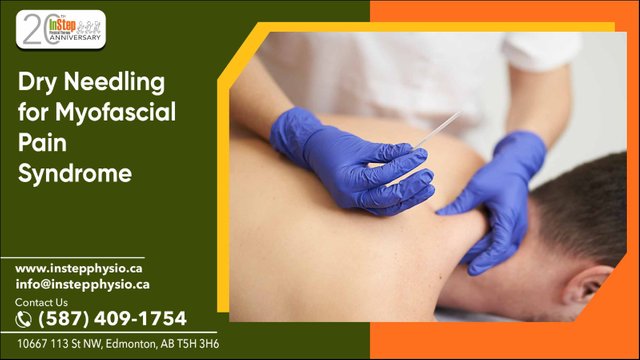
Myofascial Pain Syndrome (MPS), characterized by chronic pain due to trigger points in the muscles, can be a debilitating condition. One of the most effective treatments emerging in the field of physiotherapy is Dry Needling. In Edmonton, In Step Physical Therapy has been incorporating this technique into their practice, providing significant relief to those suffering from MPS. Dry Needling, a procedure involving the insertion of thin needles into the muscle tissue, targets these trigger points, alleviating pain and improving function.
Understanding Myofascial Pain Syndrome
Myofascial Pain Syndrome is often misunderstood and misdiagnosed, yet it affects a significant part of the population. It is a chronic condition and is characterized by pain and inflammation in the body's soft tissues. It typically manifests as a deep, aching pain in specific muscles, often accompanied by trigger points that are painful to touch. These trigger points can produce localized and referred pain, causing discomfort and limited mobility. Traditional treatments have included physical therapy, massage, and medication, but Dry Needling has emerged as a highly effective alternative.
Causes of Myofascial Pain Syndrome
Myofascial Pain Syndrome (MPS) can be triggered by a variety of factors. Repetitive motions or overuse of muscles, often seen in certain jobs or activities, are common culprits. Poor posture or prolonged sitting in awkward positions can also lead to muscle strain and the development of trigger points. Direct trauma to muscle fibres, such as that from an injury or an intense workout, is another key cause.
Stress and emotional tension can exacerbate the condition, as they often lead to subconscious muscle tightening. Additionally, certain medical conditions, such as nutritional deficiencies or hormonal imbalances, can predispose individuals to MPS.
How to identify Myofascial Pain Syndrome?
The symptoms and signs of Myofascial Pain Syndrome are distinctive but can vary widely among individuals. The primary symptom is persistent, deep muscle pain that persists or worsens over time. The affected muscles may feel tender to the touch, with palpable knots or trigger points that cause localized and referred pain. These trigger points, when pressed, can produce pain in seemingly unrelated parts of the body. Other symptoms include muscle stiffness and weakness, a limited range of motion, and possibly a popping or clicking sensation when the muscle moves. Symptoms can be aggravated by stress, cold or damp weather, and physical activity, and they may fluctuate in intensity.
The Process of Dry Needling
Dry Needling involves inserting fine, sterile needles into the trigger points or tight bands of muscle. This process aims to release the knot and relieve any muscle pain or spasms. The needles are typically left in place for a short period, during which they may elicit a muscle twitch response, a sign that the trigger point is being effectively treated. This technique is utilized as a part of a broader therapeutic approach to address the underlying causes of MPS.
Benefits of Dry Needling for MPS:
Dry Needling offers several benefits for those suffering from Myofascial Pain Syndrome. It could lead to an increased range of motion, reduction in pain, and improved muscle function. Moreover, it helps in reducing inflammation and promoting healing in the affected areas. Many patients have experienced substantial relief after undergoing Dry Needling Edmonton, even when other treatments have failed to provide significant improvement.
Integrating Dry Needling with Other Therapies
While Dry Needling is powerful on its own, its effectiveness could be enhanced when combined with other treatment modalities. Dry Needling is often integrated with other physical therapy methods, such as manual therapy, exercise, and stretching programs. This comprehensive approach ensures a holistic treatment plan, addressing not just the symptoms but also the cause of the pain.
The Extent to Which Myofascial Pain Syndrome Affects a Person
The impact of Myofascial Pain Syndrome on an individual’s life can be profound and multifaceted. Physically, the persistent muscle pain and stiffness can hamper daily activities, making simple tasks challenging. This could lead to a reduction in mobility and physical activity, further exacerbating the condition. The chronic nature of the pain can disrupt sleep patterns, leading to fatigue and reduced energy levels.
Emotionally, the constant discomfort can cause irritability, anxiety, and depression, affecting personal relationships and social life. Professionally, MPS can lead to decreased productivity and increased absenteeism, impacting job performance and career progression.
Aftercare and Managing Post-Treatment Responses
Following a Dry Needling session, it’s common for patients to experience some muscle soreness or a feeling similar to that of a mild workout. Patients are educated on effective aftercare strategies to manage these responses. These may include gentle stretching, applying heat to the affected areas, staying hydrated, and engaging in light physical activity. Proper aftercare is crucial as it aids in the recovery process and maximizes the benefits of the treatment, ensuring patients experience effective relief from their symptoms.
Navigating the Challenges of Myofascial Pain Syndrome
Dry Needling represents a paradigm shift in the treatment of Myofascial Pain Syndrome, offering a new avenue of relief for those who have long struggled with chronic muscle pain. In Edmonton, In Step Physical Therapy Edmonton is providing this innovative treatment, helping countless patients regain their mobility and quality of life. For those seeking an effective solution to MPS, Dry Needling offers a promising and clinically proven option.